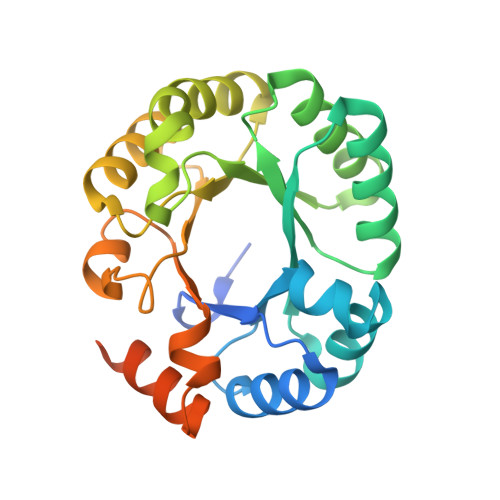Structural characterization of the molecular events during a slow substrate-product transition in orotidine 5'-monophosphate decarboxylase
Fujihashi, M., Wei, L., Kotra, L.P., Pai, E.F.(2009) J Mol Biology 387: 1199-1210
- PubMed: 19236876
- DOI: https://doi.org/10.1016/j.jmb.2009.02.037
- Primary Citation of Related Structures:
2ZZ1, 2ZZ2, 2ZZ3, 2ZZ4, 2ZZ5, 2ZZ6, 2ZZ7 - PubMed Abstract:
Crystal structures of substrate-product complexes of Methanobacterium thermoautotrophicum orotidine 5'-monophosphate decarboxylase, obtained at various steps in its catalysis of the unusual transformation of 6-cyano-uridine 5'-monophosphate (UMP) into barbituric acid ribosyl monophosphate, show that the cyano substituent of the substrate, when bound to the active site, is first bent significantly from the plane of the pyrimidine ring and then replaced by an oxygen atom. Although the K72A and D70A/K72A mutants are either catalytically impaired or even completely inactive, they still display bending of the C6 substituent. Interestingly, high-resolution structures of the D70A and D75N mutants revealed a covalent bond between C6 of UMP and the Lys72 side chain after the -CN moiety's release. The same covalent bond was observed when the native enzyme was incubated with 6-azido-UMP and 6-iodo-UMP; in contrast, the K72A mutant transformed 6-iodo-UMP to barbituric acid ribosyl 5'-monophosphate. These results demonstrate that, given a suitable environment, native orotidine 5'-monophosphate decarboxylase and several of its mutants are not restricted to the physiologically relevant decarboxylation; they are able to catalyze even nucleophilic substitution reactions but consistently maintain distortion on the C6 substituent as an important feature of catalysis.
- Graduate School of Science, Kyoto University, Sakyo-ku, Kyoto 606-8502, Japan. mfuji@kuchem.kyoto-u.ac.jp
Organizational Affiliation:

















